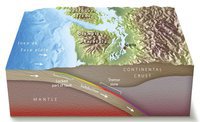According to some scientists, the Atlantic Ocean is rapidly “aging” and may soon disappear from the face of the Earth. A team of researchers from Australia found a quickly forming subduction zone on the ocean floor. Usually these zones are a sign of “aging.” Scientists do not rule out that their formation is to be blamed on the Mediterranean Sea that has been “dying” for a long time.
For many of us the oceans are symbols of eternity and immutability, but in fact they are not. Even the largest bodies of water on our planet do not last forever – they appear, develop, grow old, and then disappear. For example, look at the Tethys Ocean that existed between the ancient continents of Laurasia and Gondwana during the Late Paleozoic and Mesozoic era (320 to 66.5 million years ago). What is left of this mighty river basin? Only a few small seas – the Mediterranean, Black, and Caspian Seas and modest Persian Gulf.
Usually new oceans are born when continents break apart and hot magma pours into the faults, hardens and turns into the oceanic crust. This is how the Atlantic Ocean was created in the Mesozoic era when the supercontinent Pangaea split into southern Gondwana and northern Laurasia continents. Conversely, old oceans dye when continents collide, and the oceanic crust under their pressure sinks back into the mantle. The abovementioned Tethys disappeared when Africa and India approached Eurasia, not leaving any room for the water basin before separating these continents.
Obviously, even the oceans are subject to aging. Some of them are aging much faster than scientists assume. Recently, an Australian scientist Joao Duarte of Monash University and his colleagues found that the Atlantic Ocean does not have much left to live. This seems rather surprising because, according to the conventional opinion, this body of water is rather young. This is evidenced by the bottom of the subduction zones – linear stretches along which some blocks of the earth’s crust dip under the others. In these areas the old crust goes into the mantle, giving place to a younger mantel. The younger mantle leaves the ground during spreading – a process of an impulsive and multiple shifts of the lithosphere of the oceanic crust and filling the freed space with magma generated in the mantle.
Interestingly, spreading zones exist in the Atlantic Ocean. This process takes place in the Mid-Atlantic Ridge, and is quite active. But this indicates the young age of the ocean. In the Pacific there are many subduction zones, but quite a few places where spreading occurs, therefore it is considered old enough. However, as it turned out, the Atlantic Ocean is not that young if it has subduction zones.
Dr. Duarte’s research group was concerned with the fact that in 1755 and 1969 Portugal was rocked by powerful earthquakes whose epicenters were in the depths of the ocean. This suggests that something unusual was happening in the deep waters, for example, formation of subduction zones. Over the years the oceanic crust cools down and becomes denser, so at some point it can spontaneously become deformed, that is, bend and subside back into the mantle. Such “movements” of the crust often generate earthquakes with a deep epicenter.
In addition, it was known that there is a great deal of overt Hurst faults in the part of the Atlantic close to Gibraltar. They are small areas of the crust where some fragments overlap other rocks. Typically, these sites are markers of the beginning of a subduction zone formation. For eight years Duarte’s team was engaged in mapping the geological activity at the Portuguese coast, and as a result, scientists have found that these over thrust faults were linked to each other with transform faults – areas where the rocks rub against each other at the same level. This creates a large fault system stretching over several hundred kilometers, which, apparently, is none other than an emerging subduction zone.
But why did this zone appear in a quiet in terms of tectonic activity area? Dr. Duarte believes that the “dying” Mediterranean Sea is to blame for its emergence. In fact, the investigated location is a mere 400 km to the west of the Gibraltar Arc – a subduction zone in the west of this body of water. In addition, the researchers found that the discovered transform faults connect the Gibraltar Arc with a new subduction zone. Most likely, the remnants of the Tethys Ocean, interacting with the Atlantic crust, caused premature aging of the second largest ocean on Earth.
“We can say with some confidence that we have an example of an infection by subduction. The Mediterranean Sea, in turn, could have “caught” subduction from an ancient ocean, and so on until the beginning of time. As you can see, this process is similar to a contagious disease.
But if this is the case, then perhaps we have witnessed a turning point in the history of the Atlantic. These areas will produce cracks that sooner or later will lead to a fault in the lithospheric plate. This may cause a shift of continents and, therefore, degradation of the Ocean,” Joao Duarte commented on the study. According to his calculations, the premature death of the Atlantic can happen in 220 million years, and Europe and America will unite and the entire ocean will disappear from the face of the Earth.
Duarte’s group theory was well received by many scientists, but not everyone agrees with his “apocalyptic” outlook. This “infectious theory” can explain the formation of subduction zones. However, according to a geologist Jacques Deversher of Brest University (France), it is too early to say with confidence that in this part of the world a new area will open, and more research is needed. Duarte’s group was not going to stop their research, and now scientists are looking for a confirmation of the hypothesis in other parts of the Atlantic Ocean.
Source:Pravda.Ru
R.S

